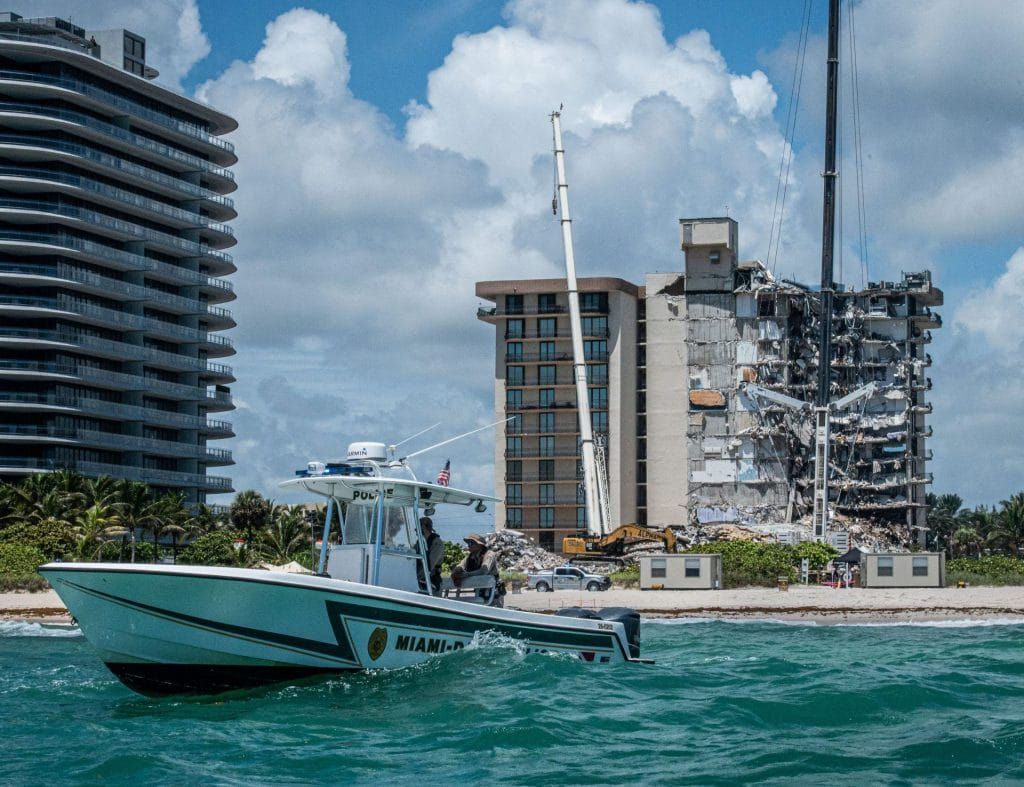In climate change era, was Surfside collapse really an unpredictable “Black Swan” event?
By John Morales | June 29, 2021
 View from the ocean of partially collapsed 12-story Champlain Towers South condo building on June 27, 2021 in Surfside, Florida. Photo by Giorgio Viera/AFP via Getty Images
View from the ocean of partially collapsed 12-story Champlain Towers South condo building on June 27, 2021 in Surfside, Florida. Photo by Giorgio Viera/AFP via Getty Images
It’s been a grim week for those of us who live in Greater Miami. The horrific images of the now-pancaked Champlain Tower in Surfside, just north of Miami Beach, remind us of how fragile life is. With the modern-day news cycle seemingly on steroids, one can become numb to the repeated mentions on-air and online of the number of dead and missing. That is, until you see pictures of entire families that are unaccounted for—husbands and wives, children and grandchildren, all most-likely gone in a matter of seconds, and in the most unexpected way.
Or was it?
A so-called “Black Swan” event is one that is very impactful but so rare, surprising, and hard to predict that it lies beyond the realm of reasonable expectations. It is usually followed by huge amounts of Monday morning quarterbacking. Speculation on what may have caused a relatively modern building to collapse upon itself began within a few hours of the Surfside disaster. Community leaders like Surfside’s former mayor Daniel Deitch warned that it was “dangerous and counterproductive to speculate” on the cause of the collapse. But in a coastal megalopolis lined with towering condominiums up and down the coast that serve as home for tens of thousands of people, questions of how a 12-story tower built in the 1980s could simply crumble could not be contained.
Experts caution that it may be many months before any definitive conclusions can be reached on which individual circumstances—or, more likely, which combination of factors—contributed to the building’s collapse. But the rationalization of the Surfside building collapse got off to a fast start. New construction of residential towers nearby had led to complaints in recent months from Champlain Tower South residents about vibrations. The day of the collapse, a study that had shown how that very building had been sinking at a rate of nearly 2 millimeters per year during the 1990s was revealed. Curiously, nothing else in its immediate vicinity was subsiding, according to the paper—only the Champlain Tower. This subsidence may have continued up to the present day, according to the lead-author of the study, in which case the total displacement could have reached just under 8 centimeters (a little over 3 inches).
That appears significant to me—but I am not an engineer.
The tower’s foundation was set upon sand and silt brought in from Biscayne Bay after the (deplorable) mangrove deforestation, with a limestone substrate underneath the organic fill into which pilings that support the building would have been anchored. This type of construction is typical of the entire Miami Beach region.
On Friday night, a 2018 engineering report was released; it called out design flaws, along with the failing of the waterproofing under the pool and planters—which had led to rebar corrosion and damaged concrete over the Champlain Tower’s garage. In preparation for a required 40-year inspection, the condo association was in the process of selecting a contractor to take on repairs of these areas as well as other problems identified by the engineers in 2018. The waterproofing problem was not in reference to any impermeable barriers under or along the perimeter of the base of the building—something which would have caught my eye, knowing how high the water table is in South Florida and the location of the building along the immediate coastline. During the weekend, however, news broke that the former maintenance chief for Champlain Tower South had frequently observed episodes when 1 to 2 feet of saltwater would flood the garage.
In other words, while we cannot yet be 100 percent certain whether sea level rise helped cause this collapse, this latest information means that I, for one, wouldn’t be surprised.
Living in one of the world’s capitals of the consequences of global warming has primed Miamian’s minds to quickly pivot to climate change even if there’s only a small suspicion that it may be contributing to a problem. After all, increasingly extreme downpours and a higher water table pushed up by the encroaching sea has resulted in more frequent and worsening flash floods. Miami’s streets even flood on sunny days; saltwater from Biscayne Bay comes up through the drains during high tide 400 percent more often than a few decades ago. And tropical storms are reaching major hurricane status with greater ease—many of them producing a greater impact on South Florida due to the stronger winds as well as a broader and deeper storm surge.
Could sea level rise or recent storm surges driven by the changing climate have caused the collapse of the Champlain Tower? I’m not ready to go there, given how several experts and an eyewitness point to the cratering of the pool deck as the catalyst for the collapse of the building. The 2018 engineering report contained numerous images of detached concrete and exposed rebar in that exact area. That corroding water would have come from above, and not the neighboring ocean. And the exposed rebar’s deterioration would have been accelerated by the overabundance of salty air in the town of Surfside.
What about the maintenance manager’s statement about saltwater inundation? Saltwater flooding of lower-level garages is an increasingly common problem on Miami’s barrier islands. With sea level alarmingly a half-foot higher than in the 1990s, plus another 1 to 2 feet expected by mid-century, Miami’s close encounters with the sea are on the upswing. Climate change in Miami was already a local problem that Floridians had internalized and personalized. Now, that awareness will likely shift into overdrive. High-rise dwellers along the coast are worried, and some are asking to be evacuated from their residences. All towers of 5 stories or higher, and built 40 years ago or more, will be inspected in Miami-Dade County.
Which brings me to Gray Swans.
I first came across the term Gray Swan during a visit at MIT with renowned atmospheric and climate scientist Kerry Emanuel. We were discussing cyclone threats, and he homed in on Tampa Bay and its perilous geography in relation to stronger future hurricanes. A major hurricane striking Tampa at just the right angle so as to cause a catastrophic storm surge—albeit a rare event—would not be surprising or hard to predict. Human nature dictates that people would be shocked by such an event and classify it as a Black Swan. But meteorologists have known that it’s only a matter of time, and when that storm surge finally happens it will be a Gray Swan event and not black.
Climate scientists have been forecasting—and, unfortunately, observations have confirmed—that sea level rise is accelerating due to thermal expansion of the oceans along with melting glaciers and ice caps. Saltwater on Miami Beach’s streets and building parking garages is hardly shocking, except that one time when an octopus came up through the drain. The effects of the surging seas on what Scientfic American called the world’s “most vulnerable coastal city” to sea level rise shifted away from Black Swan territory years ago. We won’t know whether sea level rise was a direct contributing factor to the collapse of the Champlain Tower South for months or years. Based on recent reports, it appears that building engineering and design flaws had a lot more to do with it. But the construction defects had been noted in 2018, if not before, and the tidal flooding events became commonplace years before that.
This event was rare and surprising, but arguably foreseeable.
It’s gray, not black.
Together, we make the world safer.
The Bulletin elevates expert voices above the noise. But as an independent nonprofit organization, our operations depend on the support of readers like you. Help us continue to deliver quality journalism that holds leaders accountable. Your support of our work at any level is important. In return, we promise our coverage will be understandable, influential, vigilant, solution-oriented, and fair-minded. Together we can make a difference.
Keywords: Black Swan, building collapse, climate change, climate crisis, flooding, global warming, sea level rise, subsidence, water table
Topics: Climate Change, Opinion
















This is a clear case of controlled demolition. The l
rubble pile is lacking large floor sections that are common in n a pancake collapse. The huge pyroclastic clouds, the bright flashes preceding the collapse, the speed oh collapse, the relatively short height of the rubble pile are all indications of demolitions. And the coup de’ tae in the subterranean fires which can only be attributed to demolitions. This so, by who and why are the questions you need to answer.
Is sea level rising? Or is Miami Beach sinking. The area buildings appear to be built on sand. Before we jump to Climate Change we need to look carefully at construction standards